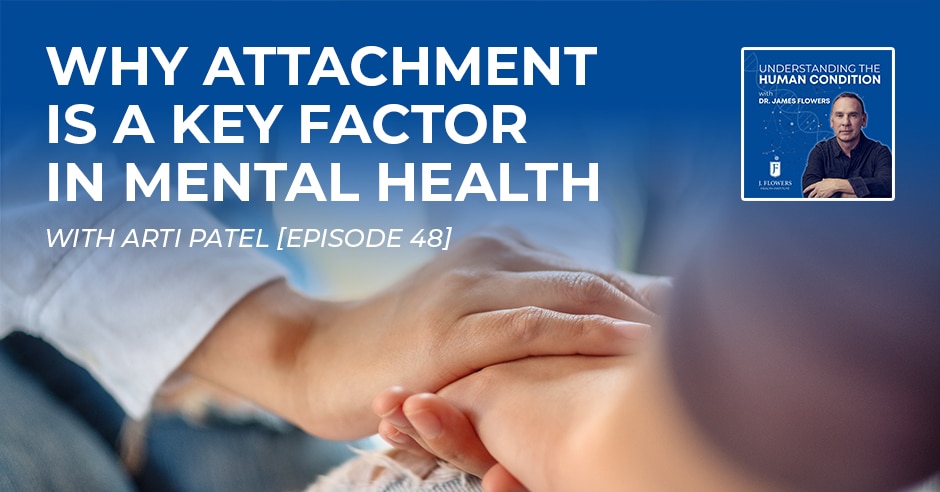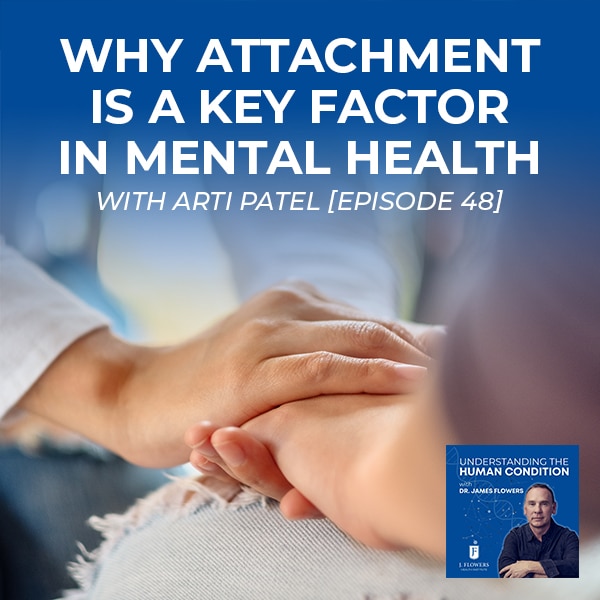
How does attachment affect your mental health? Join celebrity pain and mental health expert Dr. James Flowers, his co-host Robin French, and VIP guest Arti Patel as they discuss what attachment disorder looks like.
—
Listen to the podcast here
Why Attachment Is A Key Factor In Mental Health With Arti Patel [Episode 48]
Understanding Attachment Theory
Welcome everyone to Understanding the Human Condition. I’m your host, Dr. James Flowers, and this is my lovely co-host, Robin French. How are you?
I’m good, how are you?
I’m doing great.
I am so excited.
I know.
We’re joined by our very own primary therapist, Arti Patel. Arti.
I’m excited to be here.
We’re so glad to have you. It took a little tooth-pulling to get you here. Arti was a little nervous about coming, and I said no one could be better to talk about attachment theory. I’m so in, let’s jump right into the topic. What is attachment theory?
Attachment theory can be explained by the emotional bonds that we have with significant others, and it really starts during infancy. The care and the bond between the caregiver and the infant, but not just the quality of care. A lot of it is nonverbal and emotional space too.
Very nice.
Now, what are the different attachment styles? I have to admit, I am new to all of this. I’d never heard of this before. I didn’t realize this existed, but it’s fascinating. What are these different attachment styles? Can you describe it?
It’s very fascinating to me as well as I do my work in this. There are four different attachment styles. The first one is secure, so trusting, and independent, but still being able to express how you feel. The second one is dismissive avoidant, aloof, not feeling comfortable sharing how you feel. We can be avoiding of feelings, even though they’re within us, we can feel hurt or rejected. Anxious or preoccupied, we need constant reassurance from partners or people around us, or we want intense connection all the time and cannot get enough before the other person’s ready. Fearful avoidant, it can be a combination of avoidant and anxious as well.
Can someone have 2 or 3 of these?
Absolutely.
That’s what I see. If you can, discuss the importance of our comprehensive diagnostic evaluation and why understanding your own attachment style is important in our lives.
It’s very important because we can understand how we felt as children because that developmental lifespan is so important and our childhood experiences do shape us. It does carry over into adulthood and how aware we are about those experiences as well. I have a lot of fun when we’re doing the biopsychosocial, getting to know our adult patients or even our younger ones, just going through their experiences and hearing them talk about it is awesome.
It’s important to understand how we felt as children, as our childhood experiences shape us into adulthood.
I’ll throw this in real quickly. We weren’t planning on talking about this, but listening to you just reminds me, you’re getting ready to see a patient within our practice that was born at 24 weeks, and weighed one pound, one ounce at birth and she had no physical human connection or contact with her mother father or really anyone else for months. Do you think that that affects a person’s attachment style today?
I’m sure it has some impact on her and especially with both right the caregiver and the infant were both impacted by that.
Mom as affected probably as her.
Basically, if your needs weren’t met as a child, does that mean that you cannot foster healthy relationships?
Self-Compassion Group
Absolutely not. Through healing and having corrective experiences, you can most certainly foster healthy relationships. If we can validate our own experiences and practice that self-compassion, we can have healthy relationships.
How do you use attachment theory to help clients at J. Flowers?
Holding space for them. Holding space for them to feel safe and to be able for them to share their emotions in therapy as well, and how important that is. I think the beauty of that is too that we all work as a team together, and our team is secure, and I find that awesome because we can all work together.
I think that’s so important to the process.
I hear that a lot because I’ve done a lot of those client satisfaction surveys, and the one thing that I hear over and over and over again is that, “They made me feel safe, and heard, and understood.” I also think that a lot of it has to do with the fact, I don’t know if people know this or not, but you serve these concierge lunches to all of us, and we all do this buffet style where we sit like a family, therapists, administrative folks, the clients, and it’s just even more opportunity for everybody to bond like a family. I think it makes them feel safe, right?
Sure, it sure does, absolutely.
I wanted to ask, can you be single and work on your attachment style?
Of course.
As in single as not dating, Robin?
Yeah, exactly.
Of course, you would ask that question.
Yeah. Of course. The relationship we have with ourselves is the most important relationship. Even when you’re in a relationship or not in a relationship, we have to constantly do that inner work. That can change for everyone. That inner work can be really empowering for us.
We were talking about that in the car, actually, how we aren’t the same people that we were when we were 20, when we were 30. We do change and we should change. We should always work on ourselves.
We’re evolving human beings.
If someone is in therapy or even for those listening that may or may not be in therapy, how do we learn about our own attachment styles? How does someone learn that? Is it only in therapy? Is there something they can read?
I say come to J. Flowers because of what I said before about how we have a team of therapists. The nice thing is everybody has a primary and secondary therapist. I find we’re working together in sync because we’re training together and we’re talking about each patient. That’s really wonderful and helping them understand what that therapeutic relationship is like and what their style is like so they can also use that in their interpersonal life as well. There’s a wealth of information literature on attachment styles.
What made you become interested in attachment theory?
I’ve always enjoyed working with young people. I’ve worked in residential with small children to young adults to adolescents, and I realized how impactful attachment can be and the relationships that they have with other people.
I think it’s so critical to understand that piece and the therapeutic process.
How can a parent, for all these parents that are listening and are watching, how can they create a secure parent attachment style or environment for their child?
Holding space for feelings and that their child is not wrong for having strong feelings. That we’re not inadequate for having strong feelings and that we can feel feelings that are strong that are not happiness and joy because we want to feel a range of emotions. Helping a child understand that that’s okay and that you can come to me with these feelings.
It’s vital to validate strong feelings. We are not inadequate for having them.
We see so many people in our practice and all over the country really are with the history of trauma. What role does attachment play in dealing with trauma?
When there is trauma in childhood, that can be really hard and that can impact us in adulthood too and sometimes we can go through more traumatic experiences, but if the child had someone they could turn to for comfort. Someone who validated their experience that can be a very healing experience as well. A traumatic experience can be bad enough but when left in isolation, that can be worse.
Not only being left in isolation, but what happens if you have difficulty with attachment, and you don’t deal with it in life and you’re in a relationship. What do you often see?
A lot of avoidance. Patterns of avoidance, not being able to talk about your true feelings, because what I say is there can still be connectedness even when there’s conflict. We want to improve the quality of conflict because conflict is inevitable. It’s going to happen in all relationships.
You lead a self-compassion group at J. Flowers Health Institute. Can you tell the audience about the group and what that’s all about?
It’s been very rewarding for me just to see everyone sit in that group and process. I give them a feeling wordless and we check in. The goal for me is that I’m doing less of the talking in the group. If I can set the frame and talk about self-compassion, define what it means for them, and the goal is that they bond with each other. Even though everybody is unique in their experience, that they’re having a healing experience with each other and to be able to see that has been extremely awesome.
That’s great. How can you help our readers understand a way that they can practice self-compassion?
Taking inventory of our inner critic, how we talk to ourselves, our inner voice. We can be really judgmental. I think that’s really important to change the way we talk to ourselves and being our own best friend. How can we nurture and nourish ourselves? I think my favorite exercise for self-compassion to start thinking about those things because we have to train the mind. As human beings, we need to hear things over and over again.
It’s so difficult. I go through that with myself right? I’m too critical of myself sometimes and I think, “I didn’t do that right or why didn’t I do it better or what have you.” We can all practice this.
Attachment Disorder In Relationships
What does attachment disorder look like in relationships?
I think we touched on that that it can look like a lot of avoidance right and people who are not able to share how they feel with each other, and just people who are not talking about conflict. They are also celebrating themselves too. That we have to learn to celebrate ourselves for our limitations and our strengths.
I’m going to throw this question out there too. What happens if it’s not diagnosed? What happens? What’s the end result?
I think that that can be really hard and can lead to a lot of pain and suffering for people if they’re not aware because pain and suffering is inevitable in life, but if there’s no awareness or understanding, then that can be really hard.
I think what I see in relationships and we’re talking about clients and patients in the office, when we see this and they’re not aware of it, over time, things come out sideways in conversation whether it’s with your partner, whether it’s with your spouse or a coworker or anyone. When we don’t understand our own attachment theory or our own attachment style, I think that when we’re frustrated or we’re sad or we’re angry, if we don’t understand that and we don’t understand where it’s coming from, it comes out sideways. It can really make things blow up and be bigger than they actually are. It may seem like you’re upset about one thing and it can actually be something completely different and then we see those things.
Success Stories
Tell me either one of you, like a really good story. Do you have a story to share with a success story perhaps with someone who was suffering with this? How were they rebuilt?
I think one of my first clients who came in back in January was a young woman who was in her twenties, and very smart. Had gone to do her interior design certificate and had gone through a lot of trauma and had some attachments. She really just soaked everything up. At J. Flowers, we created the space for her and all of the outside providers and also the therapy and house. She just really took everything and just was able to practice self-compassion, understand her attachment style, and said that coming to J. Flowers was one of the best decisions she made.
What about, what have you seen in your groups that you do with attachment theory and patients recognizing when you step back and they take over the group, what have you seen positive come out of a couple of your groups?
Just a lot of empowerment and a lot of vulnerability as well. Some of them never even heard of self-compassion, or think that self-compassion is selfish. We go over why that’s not selfish and it can actually help you be more compassionate towards others. The more compassion you can practice towards yourself. They’re truly fascinated. They come with a lot of curiosity. What I hear them open up with or how they tell their story and how they can tell it in a way that’s more compassionate towards themselves instead of being shaming has been amazing to watch.
Self-compassion is not selfish. The more compassion you can practice towards yourself, the more compassionate you can be towards others.
What I’ve also noticed in relationships is that if you have two members of the relationship that don’t understand their attachment. One of them is doing work and they’re learning about themselves and they’re practicing self-compassion that the other spouse or the other partner is going, “You’re being selfish. You take care of me instead of you.” It’s like, “No, you go to therapy.” I think this is wonderful. I love what you do with us and thank you for working with us. I love talking about attachment theory. Arti, tell us about your background. Tell the audience a little bit more about yourself and education and what brought you into this field.
I’ve always been fascinated by psychology and attachment from a young age, even if I didn’t have the fancy words for it. I was born in Queens, New York, and grew up in New Jersey. Have strong Indian roots and I never thought I would leave the Northeast. Here I am in Houston. I love it and I’m so excited to be at J. Flowers and to be able to do this work. It’s been a wonderful experience just with the team here and how we are pretty secure in our attachment with each other. How we can go to each other and serve our clients.
I think the most important question I have for the day is, where’s your Queens accent?
No Jersey or Queens accent.
That’s right.
Jordan wants me to ask, what Arti thinks about your and my attachment style?
You’re going to die of no sense. I think that’s a great idea.
I’ve listened to a few episodes. It seems secure. It seems like you’ll have a good flow.
We’re healthy.
We fooled him.
She thinks we’re healthy. Good job.
Disciplining Children
I did want to ask a question though. We were talking about children and parents and making them feel secure and making them feel heard and creating that safe space but how do you discipline a child who has attachment issues?
That’s really hard because it doesn’t have to be one or the other. You can still validate their feelings and still hold a boundary. The discipline and boundaries are for safety. They’re not for punishment. It’s to create safety for them. Children often feel safer with boundaries. They need someone to tell them. That’s really important that it doesn’t have to be just because we’re validating their feelings. It doesn’t mean we’re saying yes to everything.
Consistency too. Is this something generational that’s passed on? I’ve heard generational trauma, right? Like if a parent has this, can they be passing this on to and it’s going from generation to generation?
Yeah and that can happen but I do believe that each generation gets better. I think that each generation does get better and has more awareness. That’s what I’ve seen too and we’re really modeling that as therapists for people to how to have a secure and healthy attachment. I would want a client to tell me if I upset them and I would need to validate their feelings
In working with adolescence and their parents, have you ever sat down with a parent and talking about attachment theory? Educated a parent on attachment theory so that the parent thing can then go home and talk to their children about it and educate their children about attachment theory. I don’t know why that just hit me, but maybe I’m wrong.
No, absolutely. I think that’s a really good one because at the end of the day, the parent-child relationship and the quality of that matters the most. Sometimes we focus too much on the behavior. Yes, we do have to set boundaries and keep adolescents safe, but the quality of the relationship matters the most in how an adolescent can go to their parents, and express their feelings. Sometimes that gets lost. We live in the real world. People are busy with their schedules and school. Sometimes we can come really hard on the other stuff that’s going on. Just remembering that the relationship matters the most.
At the end of the day, the quality of the parent-child relationship matters the most.
Have you seen any differences, and I’m sure that you have, between children who are adopted and children who are born into a family, like in different age groups?
Yeah, I have, and I think that really depends too on everybody’s emotional capacity. There are so many factors.
What the background was.
Yeah, there’s a lot of different factors.
I was just going to say we’re running out of time.
I cannot believe how fast it goes.
I know, right?
It’s crazy.
Understanding The Human Condition
Arti, what are your thoughts on understanding the human condition? What does that mean to you?
That means to me our humanness and how connected we are. I was thinking about this, about how our senses can greet our brain, and how we connect that all together.
That’s a good way of putting it. How our senses greet our brain.
Real quick before we go, how do you take care of yourself because you do a lot of deep therapy all day long with a lot of people, with a lot of trauma. How do you take care of our thing?
I really enjoy my family and friends. I love the sunshine. I love the beach. Those are my ways of taking care of myself.
I think yesterday, did you all go to yoga?
Yes, that was amazing. We did yoga and that was wonderful. It was truly wonderful to be able to take out time during our workday and leave and do yoga. That was a nice bonding experience for our team.
That’s so cool.
That’s one thing that you guys are really good about is professional development and team building. That’s a great benefit to working at J. Flowers Health Institute.
Did you go to yoga?
No, I didn’t get to. I think it was just the clinical team.
Good. We’ll have to go to yoga.
I’m going to Equine. I’m going to visit Melanie and do that Equine therapy.
That’s great.
There’s my field trip for the week.
There you go, perfect.
Did you go? You didn’t go?
No, I will. I’ll join.
You were working out though, I know that.
I did go work out. That’s right.
If anyone wants to reach you, both of you, how do they contact you?
I think for both Arti and myself if anybody has questions about attachment theory call Arti at the office (713) 783-6655 or just go to our website JFlowersHealth.com.
Great. Thank you everyone for spending time with us. I want to remind everyone watching that there are numerous platforms that you can find us on, YouTube, Apple Podcasts, SoundCloud, Spotify, Stitcher, and iHeart Radio. Please share this episode on social media with someone that you think it would help.
Yes because Arti’s a fantastic therapist come and see her.
She is.
Thank you, everybody. Thank you, Arti. That was really cool.
Everyone, I’m Jordan. We’re just going to remind everyone that the best path to healing is getting a comprehensive diagnostic evaluation.
There you go.
Thank you, Jordan.
Thank you.
Important Links
- Arti Patel on LinkedIn
- Flowers Health’s Facebook Profile
- Flowers Health’s Instagram Profile
- Flowers Health’s Twitter Profile
- Flowers Health’s LinkedIn Profile
- Understanding The Human Condition’s YouTube Page
- Understanding The Human Condition’s Apple Podcasts page
- Understanding The Human Condition’s SoundCloud page
- Understanding The Human Condition’s Spotify page
- Understanding The Human Condition’s iHeart Radio page






